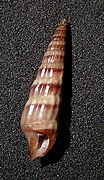Terebridae
| Terebridae | |
|---|---|

| |
| live Acus maculatus | |
| Scientific classification | |
| Domain: | Eukaryota |
| Kingdom: | Animalia |
| Phylum: | Mollusca |
| Class: | Gastropoda |
| Subclass: | Caenogastropoda |
| Order: | Neogastropoda |
| Superfamily: | Conoidea |
| Family: | Terebridae Mörch, 1852[1] |
| Genera | |
|
See text. | |
| Diversity[2] | |
| about 313 species | |
| Synonyms[3] | |
| |
The Terebridae, commonly referred to as auger shells or auger snails, is a group or family of small to large predatory marine gastropods.[3]
These gastropods have extremely high spired shells with numerous whorls, and the common name refers to the resemblance of their shells to rock drill-type drill bits.
There are about 313 known species worldwide.[2]
Taxonomy
This family consists of two following subfamilies (according to the taxonomy of the Gastropoda by Bouchet & Rocroi, 2005):
- Terebrinae Mörch, 1852 - synonyms: Acusidae; Acidae Gray, 1853 (inv.)
- Pervicaciinae Rudman, 1969
However, Terryn[2] states that the subfamily Pervicaciinae would historically include solely the * Duplicaria (and the * Pervicaria, now included in Euterebra). The other genera would belong to the subfamily Terebrinae. Since there is no clear division and currently no taxonomic need the two subfamilies are nowadays no longer accepted.[4][5]
Shell description
The shells of the sea snails in this family are typically shaped like slender augers or screws. In that respect they share certain shell characters with the family Turritellidae, the turret shells.
One characteristic that distinguishes Terebridae from Turritellidae is the short anterior canal or notch in the aperture of the shell. Terebridae shells also tend to have characteristically flattened versus convex whorls, and they often have one or two plaits on the columella.
Numerous species in this family are grouped under the genera Terebra or Hastula, and a minority of species are placed in four other genera.
Life habits
These snails are sand-dwelling carnivores which live in warmer waters. In most species, a venomous barb similar to that of the cone snails, (see Conidae), is used to stun and immobilize prey, which typically consists of various marine worms.

Genera
Genera in the family Terebridae include:[2][6]
- Cinguloterebra Oyama, 1961
- Clathroterebra Oyama, 1961
- Duplicaria Dall, 1908
- Euterebra Cotton & Godfrey, 1932
- Gemmaterebra Cotton, 1952
- Granuliterebra Oyama, 1961
- Hastula H. Adams & A. Adams, 1853
- Hastulopsis Oyama, 1961
- Impages E. A. Smith, 1873
- † Kaweka Marwick, 1931
- Myurella Hinds, 1844
- Oxymeris Dall, 1903
- Pellifronia Terryn & Holford, 2008
- Perirhoe Dall, 1908
- Pristiterebra Oyama, 1961
- Strioterebrum Sacco, 1891
- Terebra Bruguière, 1789 -- type taxon
- Terenolla Iredale, 1929
- Triplostephanus Dall, 1908
- † Zeacuminia Finlay, 1930
- Genera brought into synonymy
- Acus H. Adams & A. Adams, 1853 (synonym of Oxymeris)
- Abretia H. Adams & A. Adams, 1853: synonym of Perirhoe Dall, 1908
- Abretiella Bartsch, 1923: synonym of Perirhoe Dall, 1908
- Acuminia Dall, 1908: synonym of Hastula H. Adams & A. Adams, 1853
- Acus Gray, 1847: synonym of Oxymeris Dall, 1903
- Brevimyurella Oyama, 1961: synonym of Strioterebrum Sacco, 1891
- Decorihastula Oyama, 1961: synonym of Myurella Hinds, 1844
- Dimidacus Iredale, 1929: synonym of Terebra Bruguière, 1789
- Diplomeriza Dall, 1919: synonym of Duplicaria Dall, 1908
- Egentelaria Rehder, 1980: synonym of Hastula H. Adams & A. Adams, 1853
- Gradaterebra Cotton & Godfrey, 1932: synonym of Euterebra Cotton & Godfrey, 1932
- Hastulina Oyama, 1961: synonym of Hastula H. Adams & A. Adams, 1853
- Laeviacus Oyama, 1961: synonym of Pristiterebra Oyama, 1961
- Myurellina Bartsch, 1923: synonym of Terebra Bruguière, 1789
- Myurellisca Bartsch, 1923: synonym of Duplicaria Dall, 1908
- Noditerebra Cossmann, 1896 †: synonym of Terebra Bruguière, 1789
- Nototerebra Cotton, 1947: synonym of Oxymeris Dall, 1903
- Panaterebra Olsson, 1967: synonym of Terebra Bruguière, 1789
- Paraterebra Woodring, 1928: synonym of Terebra Bruguière, 1789
- Partecosta Dance & Eames, 1966: synonym of Euterebra Cotton & Godfrey, 1932
- Pervicacia Iredale, 1924: synonym of Duplicaria Dall, 1908
- Punctoterebra Bartsch, 1923: synonym of Strioterebrum Sacco, 1891
- Subula Schumacher, 1817: synonym of Terebra Bruguière, 1789
- Terebrina Bartsch, 1923: synonym of Terebra Bruguière, 1789
- Terebrum Montfort, 1810: synonym of Terebra Bruguière, 1789
- Vertagus Link, 1807: synonym of Terebra Bruguière, 1789
References
- ^ Mörch O. A. L. (1852). Catalogus conchyliorum quae reliquit D. Alphonso d'Arguirra et Gadea Comes de Yoldi, (1): 74.
- ^ a b c d Terryn, Y. (2007): A Collectors Guide to Recent Terebridae (Mollusca: Neogastropoda). 57 pp., 65 color plts. ConchBooks & NaturalArt, Hackenheim & Gent, ISBN 978-3-939767-01-5.
- ^ a b Gofas, S. (2012). Terebridae. World Register of Marine Species [1] 2012-10-12
- ^ WoRMS (2010). Terebrinae. Accessed through: World Register of Marine Species at http://www.marinespecies.org/aphia.php?p=taxdetails&id=411816 on 2011-04-01
- ^ WoRMS (2010). Pervicaciinae. Accessed through: World Register of Marine Species at http://www.marinespecies.org/aphia.php?p=taxdetails&id=411817 on 2011-04-01
- ^ Gofas, S. (2010). Terebridae. In: Bouchet, P.; Gofas, S.; Rosenberg, G. (2010) World Marine Mollusca database. Accessed through: World Register of Marine Species at http://www.marinespecies.org/aphia.php?p=taxdetails&id=160424 on 2010-04-01
- Bratcher T. & Cernohorsky W.O. (1987). Living terebras of the world. A monograph of the recent Terebridae of the world. American Malacologists, Melbourne, Florida & Burlington, Massachusetts. 240pp
- [2]
- Terebridae, Auger Shells
- Terebra dislocata, Atlantic Auger or Eastern Auger
- NC Sea Grant, Seashells of North Carolina Field Guide
- [3]
- Shell Catalogue Family Terebridae and Terebridae Images
Further reading
- Terryn Y. & Holford M. (2008). "The Terebridae of Vanuatu, with a revision of the * Granuliterebra Oyama, 1961". Visaya Supplement 3 (Malacological Journal of Conchology, Inc., Cebu, Philippines).








